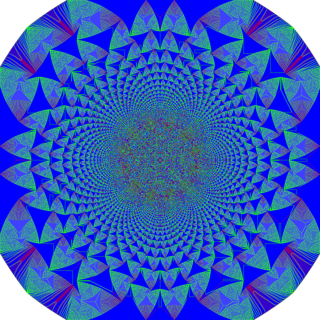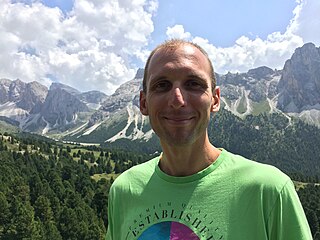Related Research Articles

The edge of chaos is a transition space between order and disorder that is hypothesized to exist within a wide variety of systems. This transition zone is a region of bounded instability that engenders a constant dynamic interplay between order and disorder.
The year 1987 in science and technology involved many significant events, some listed below.

Self-organized criticality (SOC) is a property of dynamical systems that have a critical point as an attractor. Their macroscopic behavior thus displays the spatial or temporal scale-invariance characteristic of the critical point of a phase transition, but without the need to tune control parameters to a precise value, because the system, effectively, tunes itself as it evolves towards criticality.
Stochastic resonance (SR) is a phenomenon in which a signal that is normally too weak to be detected by a sensor, can be boosted by adding white noise to the signal, which contains a wide spectrum of frequencies. The frequencies in the white noise corresponding to the original signal's frequencies will resonate with each other, amplifying the original signal while not amplifying the rest of the white noise – thereby increasing the signal-to-noise ratio, which makes the original signal more prominent. Further, the added white noise can be enough to be detectable by the sensor, which can then filter it out to effectively detect the original, previously undetectable signal.
Per Bak was a Danish theoretical physicist who coauthored the 1987 academic paper that coined the term "self-organized criticality."

The Bak–Sneppen model is a simple model of co-evolution between interacting species. It was developed to show how self-organized criticality may explain key features of the fossil record, such as the distribution of sizes of extinction events and the phenomenon of punctuated equilibrium. It is named after Per Bak and Kim Sneppen.

Tang Chao is a Chair Professor of Physics and Systems Biology at Peking University.
Extremal optimization (EO) is an optimization heuristic inspired by the Bak–Sneppen model of self-organized criticality from the field of statistical physics. This heuristic was designed initially to address combinatorial optimization problems such as the travelling salesman problem and spin glasses, although the technique has been demonstrated to function in optimization domains.
Objective-collapse theories, also known as models of spontaneous wave function collapse or dynamical reduction models, are proposed solutions to the measurement problem in quantum mechanics. As with other theories called interpretations of quantum mechanics, they are possible explanations of why and how quantum measurements always give definite outcomes, not a superposition of them as predicted by the Schrödinger equation, and more generally how the classical world emerges from quantum theory. The fundamental idea is that the unitary evolution of the wave function describing the state of a quantum system is approximate. It works well for microscopic systems, but progressively loses its validity when the mass / complexity of the system increases.
Kurt Gottfried was an Austrian-born American physicist who was professor emeritus of physics at Cornell University. He was known for his work in the areas of quantum mechanics and particle physics and was also a co-founder with Henry Way Kendall of the Union of Concerned Scientists. He wrote extensively in the areas of physics and arms control.
Within quantum technology, a quantum sensor utilizes properties of quantum mechanics, such as quantum entanglement, quantum interference, and quantum state squeezing, which have optimized precision and beat current limits in sensor technology. The field of quantum sensing deals with the design and engineering of quantum sources and quantum measurements that are able to beat the performance of any classical strategy in a number of technological applications. This can be done with photonic systems or solid state systems.

In condensed-matter physics, a collision cascade is a set of nearby adjacent energetic collisions of atoms induced by an energetic particle in a solid or liquid.
Dante R. Chialvo is a professor at Universidad Nacional de San Martin. Together with Per Bak, they put forward concrete models considering the brain as a critical system. Initial contributions focussed on mathematical ideas of how learning could benefit from criticality. Further work provided experimental evidence for this conjecture both at large and small scale. He was named Fulbright Scholar in 2005 and elected as a Fellow of the American Physical Society in 2007 and as Member of the Academia de Ciencias de America Latina in 2022.
Maya Paczuski is the head and founder of the Complexity Science Group at the University of Calgary. She is a well-cited physicist whose work spans self-organized criticality, avalanche dynamics, earthquake, and complex networks. She was born in Israel in 1963, but grew up in the United States. Maya Paczuski received a B.S. and M.S. in Electrical Engineering and Computer Science from M.I.T. in 1986 and then went on to study with Mehran Kardar, earning her Ph.D in Condensed matter physics from the same institute.

Matjaž Perc is Professor of Physics at the University of Maribor in Slovenia, and director of the Complex Systems Center Maribor. He is member of Academia Europaea and among top 1% most cited physicists according to Thomson Reuters Highly Cited Researchers. He is Outstanding Referee of the Physical Review and Physical Review Letters journals, and Distinguished Referee of EPL. He received the Young Scientist Award for Socio-and Econophysics in 2015. His research has been widely reported in the media and professional literature.
Raymond Ethan Goldstein FRS FInstP is Schlumberger Professor of Complex Physical Systems in the Department of Applied Mathematics and Theoretical Physics (DAMTP) at the University of Cambridge and a Fellow of Churchill College, Cambridge.

Peter E. Toschek was a German experimental physicist who researched nuclear physics, quantum optics, and laser physics. He is known as a pioneer of laser spectroscopy and for the first demonstration of single trapped atoms (ions). He was a professor at Hamburg University.
Stochastic thermodynamics is an emergent field of research in statistical mechanics that uses stochastic variables to better understand the non-equilibrium dynamics present in many microscopic systems such as colloidal particles, biopolymers, enzymes, and molecular motors.
Deepak Dhar is an Indian theoretical physicist known for his research on statistical physics and stochastic processes. In 2022, he became the first Indian to be awarded the Boltzmann Medal, the highest recognition in statistical physics awarded once every three years by IUPAP, for exceptional contributions to the subject.

Crispin William Gardiner is a New Zealand physicist, who has worked in the fields of quantum optics, ultracold atoms and stochastic processes. He has written about 120 journal articles and several books in the fields of quantum optics, stochastic processes and ultracold atoms